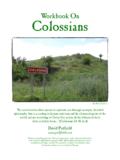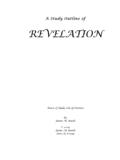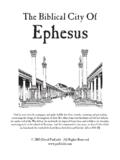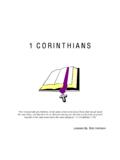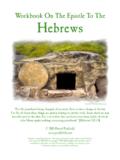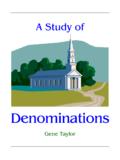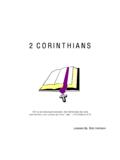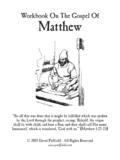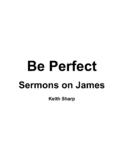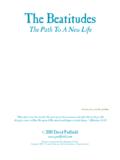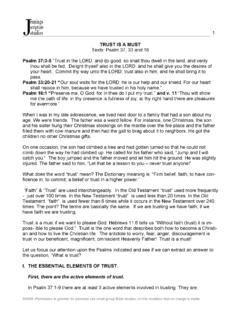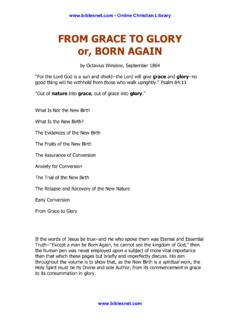Transcription of Evidences for Belief - Church of Christ in Zion, Illinois
1 The gospel of john : Evidences for BeliefCompiled by Gene TaylorThe gospel of john : Evidences for Belief Gene Taylor1 PrefaceThe Book of john is different from the other gospels in a number of ways. It not only provideswonderful insights into the life and ministry of Jesus with the stated purpose of generating Belief in Jesusas the Christ , the Son of God ( john 20:30-31) but also relates the reasons behind many of the activitiesof Jesus and His studying john s gospel , one can see the culmination of God s eternal purpose in His only begottenSon. Jesus was not a reluctant participant in the plan of the Father, rather He willingly laid down His lifeas a sacrifice for sin. Studying this gospel allows the student to see the step-by-step process by whichthat purpose is C. Tenney s commentary on john s gospel , john : The gospel of Belief (Grand Rapids:Erdman s, 1948), is a good companion to your study.
2 His general outline of the book of john serves asthe guide for this this study be of value to you. May you fully come to believe that Jesus is the Christ , the Son ofGod. And may you have life in His name. Gene Taylor December 2005 The gospel of john : Evidences for Belief Gene Taylor2 Table of ContentsPreface ..1 Table of Contents ..2An Outline of the gospel of john ..3 Lesson One: Introduction and Prologue ..5 Lesson Two: The Period of Consideration I - Early Disciples ..7 Lesson Three: The Period of Consideration II - Interviews ..9 Lesson Four: The Period of Controversy ..11 Lesson Five: The Period of Conflict I ..13 Lesson Six: The Period of Conflict II ..15 Lesson Seven: The Period of Crisis ..17 Lesson Eight: The Period of Conference I - Transition ..18 Lesson Nine: The Period of Conference II - The Conferences ..20 Lesson Ten: The Period of Consummation.
3 22 Lesson Eleven: The Epilogue ..24 Lesson Twelve: Review I ..25 Lesson Thirteen: Review II ..27 Gene Taylor, 1997. All Rights gospel of john : Evidences for Belief Gene Taylor3An Outline of the gospel of JohnI. The Prologue (1:1-18)II. The Period of Consideration (1:19 - 4:54)The Witness of john the Baptist. (1:19-34)The Presentation of john 's Disciples. (1:35-51)The Wedding at Cana. (2:1-11)The First Appearance at Jerusalem. (2:12-22)The Interview with Nicodemus. (2:23 - 3:21)The Confession of john the Baptist. (3:22-36)The Samaritan Woman. (4:1-42)The Nobleman at Capernaum. (4:43-54)III. The Period of Controversy (5:1 - 6:71)The Man at the Pool. (5:1-18)The Claims of Jesus. (5:19-29)The Witness. (5:30-47)The Feeding of the 5,000. (6:1-15)The Walking on the Water. (6:16-21)The Discourse on the Bread of Life. (6:22-71)IV. The Period of Conflict (7:1 - 11:53)The Unbelief of the Brethren.
4 (7:3-9)The Bewilderment of the People. (7:10-13)The Public Appearance. (7:14-19, 21-24, 33, 34)The Popular Response. (7:20, 25-32, 35, 36)The Climactic Appeal of Jesus. (7:37-52)**The Woman Taken in Adultery. (7:53 - 8:11)**The Address to the Pharisees. (8:12-30)The Discourse to the Believing Jews. (8:31-59)The Healing of the Man Born Blind. (9:1-41)The Discourse on the Good Shepherd. (10:1-18)The Division Among the Jews. (10:19-21)The Argument in Solomon's Porch. (10:22-42)The Raising of Lazarus. (11:1-53)The gospel of john : Evidences for Belief Gene Taylor4V. The Period of Crisis, 11:54 - 12:36aThe Retirement to Ephraim. (11:54-57)The Return to Bethany. (12:1-11)The Entry into Jerusalem. (12:12-19)The Visit of the Greeks. (12:20-36a)VI. The Period of Conference, 12:36b - 17:26 Transition. (12:36b - 13:30)Author s Parenthesis. (12:36b-43)The Appeal of Jesus. (12:44-50)The Last Supper.
5 (13:1-20)The Dismissal of the Traitor. (13:21-30)Conference with the Disciples. (13:31 - 16:33)Conference on Preparation. (13:31 - 14:31)The Introductory Announcement. (13:31-35)The Question of Peter. (13:36-38)The Discussion of Destiny. (14:1-4)The Question of Thomas. (14:5-7)The Question of Philip. (14:8-11)The Instruction Resumed. (14:12-21)The Question of Judas. (14:22-24)The Discourse Completed. (14:25-31)Conference on Relationships. (15:1-27)The Relation of the Believers to Jesus. (15:1-11)The Relation of the Believers to Each Other. (15:12-17)The Relation of the Believers to the World. (15:18-27)Conference on Revelation. (16:1-33)The Revelation Explained. (16:1-6)The Consequence of Revelation. (16:7-15)The Revelation by the Resurrection. (16:16-24)The Revelation by Proclamation. (16:25-33)Conference with the Father. (17:1-26)VII. The Period of Consummation (18:1 - 20:31)The Betrayal.
6 (18:1-11)The Trial Before Annas. (18:12-27)The Interview with Pilate. (18:28 - 19:16)The Crucifixion. (19:17-37)The Burial. (19:38-42)The Resurrection. (20:1-29)VIII. The Epilogue (21:1-25)(Merrill C. Tenney, john : The gospel of Belief , Grand Rapids: Erdmans, 1948) The gospel of john : Evidences for Belief Gene Taylor5 Lesson One: Introduction and PrologueText: john 1:1-18I. Author: The Apostle evidence : Church Fathers (Irenaus, Clement of Alexandria, Tertullian, Origen, andHippolytus). He must have been a He must have been a resident of clearly implies he was an eyewitness of many events in Christ s earthly apparently identified himself as the disciple whom Jesus loved. 5. The style and vocabulary of the three epistles of john bear a striking resemblance to The life of john (from Scripture). name is mentioned almost twice as many times as those of the other three gospel He was a son of Zebedee and His life as a disciple.
7 Was first a disciple of john the Baptist, then of Jesus. was the disciple whom Jesus loved. was one of the inner circle which consisted of Peter, James and The BookA. The time and place of Time: Somewhere about 85 to 90 Place: Tradition says The purpose of the was written to convince readers that Jesus was both divine and was written to generate and reinforce Belief on Jesus as the Christ in order to have thereaders gain life. ( john 20:30-31)C. Distinctive features of the It is the most selective of the It contains many great sermons and topical places the most emphasis on the deity of Jesus through His own possesses a great simplicity of of its narrative is centered around Christ s visits to Jerusalem to observe Structure of the formal statement of the author in 20:30-31 speaks of its structure. And truly Jesusdid many other signs in the presence of His disciples, which are not written in this book;but these are written that you may believe that Jesus is the Christ , the Son of God, andthat believing you may have life in His name.
8 Outstanding words are found in it: signs, believe, and life. The gospel of john : Evidences for Belief Gene Taylor6 attests to the content of the )A selective )An attested )An apologetic )An interpretive )A definitive )An effective of the divisions are divisions of action. (See the outline of the book by Merrill C. Tenney) chronological divisions. Actual chronology begins at 1 Three geographical Unit one centers in Galilee around Capernaum and Unit two relates to Unit three deals with Jerusalem and The Prologue (1:1-18) or what is referred to as the Word? Give evidence from the text to support your answer. all statements made about the Word in verses one through eighteen. do you think this term is used to describe this person? Relate your explanation to the text. is john who is referred to in the text? What was his mission or function?
9 What was histestimony about Jesus? is what is described in verses nine through eleven to be considered a great tragedy? how Jesus' coming to the earth divided people into two camps. difference does it make whether one believes on Jesus Christ ? is meant by the phrase and the Word became flesh? (v. 14) was the purpose, according to verses fourteen through eighteen, of the incarnation of Jesus? what this text teaches about gospel of john : Evidences for Belief Gene Taylor7 Lesson Two:The Period of Consideration I - Early DisciplesText: john 1:19 - 2:11 Introduction by john the Baptist (1:19-34) 1. Why were questions raised about whether john was:a. The Christ in light of Luke 3:15?b. Elijah in light of Malachi 4:5-6?c. The prophet in light of Deuteronomy 18:15-19 and john 6:14 and 7:40? may john 's denial that he was Elijah (v. 21) be explained consistently with Matthew 11:13-14;17:10-13 and Luke 1:17?
10 How and why john identified himself. these verses, list some testimonies that john gave concerning Jesus. (At least four or five items) is meant by the phrase the Lamb of God? did john recognize Jesus as the Messiah?Disciples (1:35-51) did the disciples of john come to believe on Jesus? the testimony of the following men in relation to Nathaniel. what grounds were the disciples listed in the previous question able to reach their conclusionsconcerning Jesus? is the meaning of verse 51 as it alludes to Genesis 28:10-17?The gospel of john : Evidences for Belief Gene Taylor8 The Sign at the Marriage Feast (2:1-11) was the miracle performed at the marriage feast in Cana? circumstances brought this miracle about? effect did this sign have on the disciples? Did they not believe in Him before?The gospel of john : Evidences for Belief Gene Taylor9 Lesson Three:The Period of Consideration II - InterviewsText: john 2:12 - 4:54 The Scourging of the Temple in Jerusalem (2:12-22) characteristic of Jesus is manifested by this incident?
